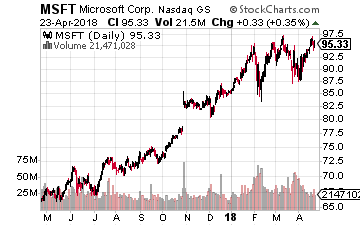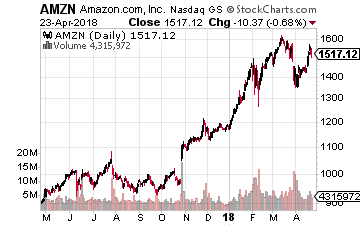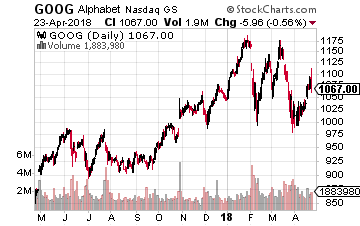Maybe you were thinking about investing into the cloud computing sector. I’m here to tell you that investing into the latest computing trend is changing, much along the lines of transportation changed the horse and buggy era when automobiles came on to the scene.
The technology research firm Forrester Research says that the Internet of Things – and the coming deluge of sensors and data – make a good bit of cloud computing passé. It will be more practical and efficient to process all of this data right on the spot where it is being collected.
In other words, data will be processed not in a centralized cloud, but at the edge of the network. Thus you get the term ‘edge computing’.
Welcome to Edge Computing
This makes sense. Think about an autonomous car. Some estimate that these data centers on wheels generate as much as a gigabyte of data every second. Doesn’t it make sense then to process all that data from radar, lidar, cameras and other sensors right there instead of sending it all up to the cloud and then wait to have an answer back to the vehicle? That’s the logic behind Nvidia’s Drive PX Pegasus artificial intelligence (AI) platform.
Peter Levine, general partner at the venture capital firm Andreessen Horowitz, also sees edge computing as the future. He believes that the proliferation of devices such as autonomous vehicles, drones and robots are going to require very rapid processing of data. The data needed in such a short time frame means, Levine believes, that sending data up to the cloud and back to get an answer will simply be too slow. Slow responses, for example, in autonomous cars could mean crashes and fatalities.
Of course, there are privacy issues too. Some data is just too sensitive to be sent to the cloud where it might remain on the public device it was sent to. Apple is leading the way with devising ways for its users to keep control of more of their personal data on their own devices.
Edge computing will become a big business. In October 2017, the IT research firm Gartner estimated that by 2022, half of all data generated by businesses will come from smart edge devices – IoT sensors as well as smartphones and PCs – rather than from the cloud or their own data centers. That is no doubt part of the reason behind the forecast from TrendForce that the edge computing market of products and services will enjoy a compound annual growth rate (CAGR) of more than 30% from 2018 to 2022.
But that doesn’t mean cloud computing is dead. It will still play an important role. Let’s go back to the example of the autonomous vehicles. These vehicles, at the end of a day of driving, send all the data collected to the cloud. This data can then be used by the vehicle manufacturers to ‘train’ and refine their software to improve vehicle safety and performance. In other words, the cloud will still handle the most intensive data storage and processing needs.
This new reality in computing suggests to me the best way to invest in edge computing, while still keeping exposure to cloud computing, is through certain stocks.
Edge Computing Stocks
 At the top of that stock list is Microsoft (Nasdaq: MSFT). When Satya Nadella first became the CEO, he said the company would pursue a “cloud-first, mobile-first” strategy. But in 2017, Nadella updated the strategy to say that Microsoft is all about the “intelligent cloud and intelligent edge.” The company has filed nearly 300 patents in the field.
At the top of that stock list is Microsoft (Nasdaq: MSFT). When Satya Nadella first became the CEO, he said the company would pursue a “cloud-first, mobile-first” strategy. But in 2017, Nadella updated the strategy to say that Microsoft is all about the “intelligent cloud and intelligent edge.” The company has filed nearly 300 patents in the field.
In last quarter’s earnings report, Microsoft showed a surge in business (revenues nearly doubled) for its centralized cloud data centers. Nadella though gave a counter-intuitive reason for the surge: that growing interest in edge computing was the reason. More customers were turning to Microsoft to deal with their edge needs, which in turn fed Microsoft’s centralized cloud business.
Microsoft has a product called the Azure Stack that offers a set of public cloud services inside a data center. This gives a customer public cloud-like resources at the data center level without having to move data back and forth from the public cloud. Carnival Cruise Lines has used Azure Stack on some of its cruise ships to power many of the day-to-day operations.
It also has launched Azure IoT Edge which it says is “a dynamic software platform that delivers cloud services to edge devices, making hybrid cloud and edge IoT solutions a reality.”
Microsoft’s results in the last quarter do seem to confirm what Peter Levine of Andreesson Horowitz said several months ago, “There’s going to be a symbiotic relationship between the edge and the cloud.”
 The next company is Amazon.com (Nasdaq: AMZN), which is the biggest public cloud provider with its AWS service. It has a product called Greengrass that provides a set of computing services directly on IoT devices when public cloud services are not available. Greengrass builds on top of AWS IoT and AWS Lambda, its serverless computing service.
The next company is Amazon.com (Nasdaq: AMZN), which is the biggest public cloud provider with its AWS service. It has a product called Greengrass that provides a set of computing services directly on IoT devices when public cloud services are not available. Greengrass builds on top of AWS IoT and AWS Lambda, its serverless computing service.
Then there is also Alphabet (Nasdaq: GOOG) and its platform for intelligent IoT services. Google Cloud IoT is a comprehensive set of fully managed and integrated services that allows businesses to securely connect, manage, and ingest IoT data from devices dispersed around the world at a large scale. That data can then be processed and analyzed in real time to take actions as necessary.

The bottom line is that all the major players in cloud computing are embracing edge computing in one way or another. You should embrace these stocks as investments in the future of computing.
Buffett just went all-in on THIS new asset. Will you?
Buffett could see this new asset run 2,524% in 2018. And he's not the only one... Mark Cuban says "it's the most exciting thing I've ever seen." Mark Zuckerberg threw down $19 billion to get a piece... Bill Gates wagered $26 billion trying to control it...
What is it?
It's not gold, crypto or any mainstream investment. But these mega-billionaires have bet the farm it's about to be the most valuable asset on Earth. Wall Street and the financial media have no clue what's about to happen...And if you act fast, you could earn as much as 2,524% before the year is up.
Click here to find out what it is.
Source: Investors Alley
